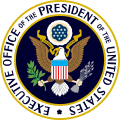 | |
| Agency overview | |
|---|---|
| Formed | November 23, 1993 |
| Headquarters | 725 17th Street, Washington, D.C. |
| Agency executive |
|
| Parent agency | Executive Office of the President |
| Website | https://trumpwhitehouse.archives.gov/ostp/nstc/ |
The National Science and Technology Council (NSTC) is a council in the Executive Branch of the United States. It is designed to coordinate science and technology policy across the branches of federal government.
